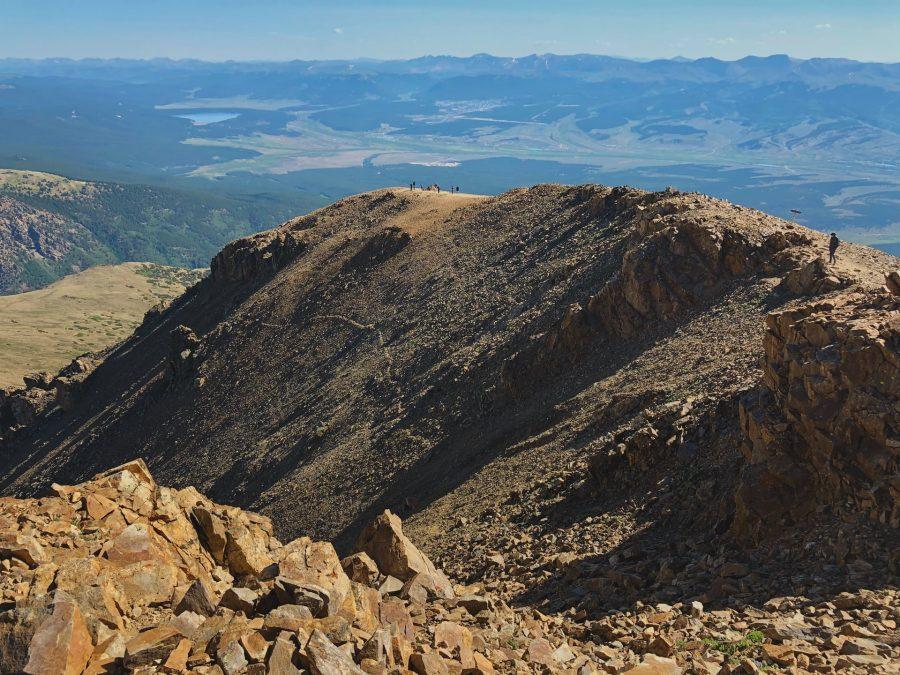There are 58 peaks in Colorado that exceed 14,000 feet. While climbing fourteeners comes with many challenges, it can also be incredibly rewarding. Colorado State University students share their experiences and offer advice to future hikers.

Mt. Quandary: 14,265 ft.
For communications sophomore Jonathan Weaver, Mt. Quandary is one of 10 summits he’s completed. “It always makes me feel small and insignificant,” Weaver said. “You’re just a tiny figure on top of a big mountain and you’re just kind of in awe.” Weaver advises inexperienced hikers to take care of their bodies. “Sometimes I get in the groove, and I neglect to pay attention to what my body needs,” he said. “I have to make a conscious effort to stay hydrated and eat along the way.” Weaver said his favorite part of hiking 14ers is, “just the peace and quiet up there and the sheer beauty of everything around. That’s kind of what hooked me.”
Mt. Elbert: 14,439 ft.
Mt. Elbert was the first and only 14er hike for journalism and spanish senior Rachel Holzhaeuser. “I had never done it so I wanted to see what all the hype was about,” she said. Holzhaeuser emphasizes the importance of being prepared. She said if she were to do it again, “I would not have worn shorts, I didn’t have any food, and I would break in my hiking boots first because I got blisters.” Despite all of those challenges, Holzhaeuser said, “I’m glad I did it. You think you can’t do it when you’re doing it but then you get to the top and you can see everything and you get to just laugh.”
Mt. Sherman: 14,035 ft.
Biochemistry senior John Bacovcin climbed Mt. Sherman two summers ago with his father. “I was born in Colorado, and I’ve been hiking all my life,” Bacovcin said. An important piece of advice he gives is to, “Start early. You need to summit by noon because if you’re above tree line by the time the afternoon thunderstorms hit, you’re the tallest thing on the mountain.” For Bacovcin, climbing a 14er is one of many ways to become a “true Coloradoan.” “I definitely think it’s a rite of passage to climb a 14er,” he said. “It’s like a badge of honor that you can wear that says ‘I climbed above 14,000 feet and there’s hardly any oxygen but I did it and that’s awesome.”
Mt. Wetterhorn: 14,016 ft.
Human dimensions of natural resources sophomore Warren Hartman volunteered with the Colorado Fourteeners Initiative to help maintain the trails on Mt. Wetterhorn. “It’s just an invaluable experience,” Hartman said. “It just makes you think about how lucky we are to have these gorgeous places, and if more people could see them they’d probably want to save them.” Hartman acknowledges that, “I think it’s dumb when people get exclusive about it,” he said. “Here [in Colorado] are 14ers that most everybody can climb. I don’t think that culture should discourage people from trying it.”

Longs Peak: 14,259 ft.
Biology sophomore Kayla Ashland summited Longs Peak in September. Ashland offers some tips for other novice hikers. “I would advise people to go with someone who knows what they are doing,” she said. “Pack light but with enough food and water to keep yourself from crashing.” Ashland also emphasized the importance of listening to your body. “Be patient with yourself. It’s okay to take breaks and enjoy the views. Trust your body, but know your limits and most importantly stay safe.” Ashland said she will most likely not attempt to climb another 14er. “I was proud of myself, but I was pretty sure I had done my first and last 14er in the same day.”
Mt. Bierstadt: 14,065 ft.
Mt. Bierstadt was the first of three 14er summits for civil engineering sophomore Kyra Hewett. “I remember climbing up the final few boulders, catching my breath and turning around to see the mountain I had just climbed,” she said. “I remember being so humbled by how large mountains can be and how small humans are. The view was insane. It was so euphoric and breathtaking.” Hewett finds significance in each hike she completes. “I think within every 14er ascent comes a lesson that is applicable in life. For Bierstadt, it was to be amazed by the things we tend to take for granted.” For Hewett, climbing 14ers offers a much-needed escape. “I am addicted to escaping my everyday life to get out, unplug and breathe in some fresh mountain air,” she said.
What’s in Your Pack?
Hikers listed the top five essentials to have in your backpack when climbing a 14er.
- Water: Bring between 2 and 4 liters of water to ensure proper hydration.
- Snacks: It’s important to fuel your body to make up for the energy expended while climbing a mountain. High-protein snacks like nuts or energy bars are a great option for staying energized on the trail.
- Extra layers: Weather can change at a moment’s notice at such high elevations. Bring a warm layer and rain gear. A hat and gloves can also come in handy. Note: Avoid cotton fabrics. Technical fabrics will wick sweat and moisture and keep you warm and comfortable.
- First aid kit: It’s always good to prepare for the worst. Be sure to include moleskin for blisters, pain relievers, and bandages for cuts and scrapes.
- Sun protection: UV exposure increases by 10 percent for every 3,280 feet in elevation gain. Sun screen and chap stick are necessities at 14,000 feet.




































